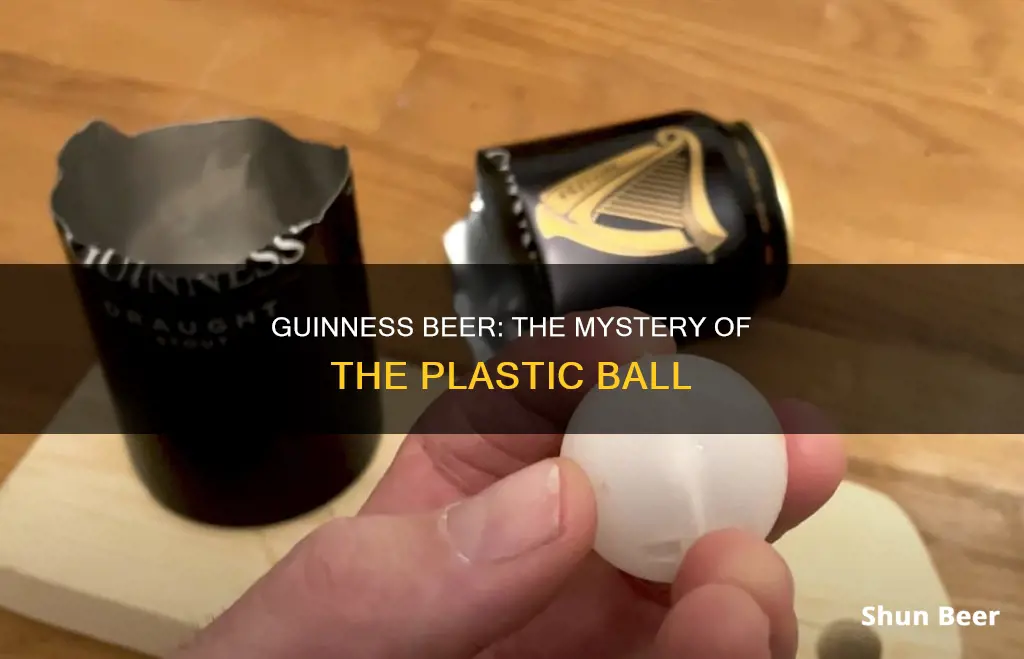
If you've ever opened a can of Guinness, you may have noticed a small plastic ball rattling around inside. This is called a widget, and it's there to give your beer a silky, creamy head, just like a freshly poured pint. Guinness brewers patented the widget idea in 1969, but it wasn't until 1989 that they released their first-generation widget, a flattened disc that sat at the bottom of the can. However, if the beer was warm, it could overflow once the can was opened. In 1997, Guinness introduced the floating, spherical widget we know today, dubbed the Smoothifier, which solved this issue. The widget is filled with nitrogen, which is released when the can is opened, infusing the beer with tiny bubbles and creating that signature thick, creamy head.
| Characteristics | Values |
|---|---|
| Name | Widget |
| Material | Food-grade plastic |
| Shape | Spherical |
| Size | Golf-ball sized |
| Colour | White |
| Function | Releases nitrogen into the beer to create a smooth, creamy head |
| Inventor | Guinness |
| First Used | 1989 |
What You'll Learn

The widget is hollow, spherical, and ping-pong ball-like
The widget in a can of Guinness is a hollow, spherical piece of food-grade plastic with a tiny hole in it. It looks like a ping pong ball, but smaller. The widget was developed by Guinness in 1969 to give their canned brews a silky, creamy head. During the canning process, brewers add liquid nitrogen to the beer immediately before sealing it. The liquid nitrogen quickly evaporates, creating pressure inside the can. This forces gas and liquid into the widget through its tiny hole.
When the can is opened, the pressure inside drops to equalize with the room's pressure. However, the pressure inside the widget remains higher than the surrounding beer, causing the nitrogenated beer to squirt out of the widget and into the beer. This creates a burst of tiny nitrogen bubbles that rise to the top of the beer, forming a thick, creamy head—just like a freshly poured pint of Guinness.
The widget is essential because Guinness uses nitrogen to give its beer a smoother and more delicate taste compared to beers carbonated with carbon dioxide. Nitrogen bubbles are smaller, creating a more stable head with a velvety "mouthfeel" without the acidic bite of carbonation. However, maintaining tasty levels of nitrogen in packaged beers is challenging once they are opened. The widget solves this problem by slowly releasing nitrogen into the beer when the can is opened.
The widget wasn't always spherical. The first-generation widget, released in 1989, was a flattened disc that sat at the bottom of the can. While it worked well with cold beer, it caused the beer to overflow if served warm. In 1997, Guinness introduced the floating, spherical widget we know today, dubbed the "Smoothifier," to address this issue.
The Irish Pride: Guinness Beer's Roots and Heritage
You may want to see also

It was developed in 1969, but not used until 1989
The plastic widget, or "ball", in Guinness beer was first patented in 1969. However, it wasn't until 1989 that Guinness released its first-generation widget to the market.
The widget was developed by Guinness brewers Tony Carey and Sammy Hildebrand at the company's St James's Gate Brewery in Dublin. The idea was to create a system for producing draught-type Guinness from cans or bottles through the discharge of gas from an internal compartment.
The original widget was a plastic disc that sat at the bottom of the can. It worked well when the beer was served cold, but if the beer was warm, the can would overflow when opened due to the nitrogen being overly pressurised.
In 1984, Ernest Saunders centralised the company's research and development, and work restarted on the widget invention under the direction of Alan Forage. The plan was to introduce a plastic capsule into the can, pressurise it during the filling process, and then allow it to release this pressure in a controlled manner when the can was opened. This would create a creamy head, a characteristic of draught Guinness.
It took 20 years of research and development to find a commercially viable solution for producing draught-type Guinness in cans or bottles. Finally, in 1989, the first-generation widget was released to the market.
Guinness Beer: Healthy or Harmful?
You may want to see also

It releases nitrogen into the beer
The plastic ball in a can of Guinness is known as a widget. It is a hollow, spherical piece of food-grade plastic with a tiny hole in it. During the canning process, brewers add liquid nitrogen to the beer before sealing the can. The liquid nitrogen quickly evaporates, creating pressure inside the can. This pressure forces gas and liquid into the widget through its tiny hole.
When the can is opened, the widget releases the nitrogenated beer into the rest of the brew, giving it a velvety texture. This release of nitrogen also creates the famous ""surge and settle" effect and a creamy head, similar to a draught Guinness. Nitrogen bubbles are smaller than carbon dioxide bubbles, resulting in a smoother and more delicate drinking experience.
The widget was invented by the Guinness team in 1968 (or 1969, according to some sources) to bring the draught experience to canned beer. The initial design, a flat sphere resting at the bottom of the can, worked well when the beer was served cold but caused the can to burst open when warm. In 1997, Guinness introduced a redesigned, floating, spherical widget, dubbed "The Smoothifier," to address this issue.
The widget has been a significant innovation for Guinness, allowing them to deliver the iconic taste and texture of Guinness Draught in a can. It is also credited for providing a perfectly smooth beer that is unmistakably Guinness every time.
Guinness vs Beer: What Sets Them Apart?
You may want to see also

It creates a thick, creamy head
The plastic ball in a can of Guinness is called a widget. It was developed by Guinness in 1969 to give their canned brews a silky, creamy head. It is a hollow, spherical piece of food-grade plastic with a tiny hole in it. It looks like a little ping pong ball.
During the canning process, brewers add liquid nitrogen to the beer immediately before sealing it up. The liquid nitrogen quickly evaporates in the container. But since the can is sealed, this creates pressure inside it, which then forces gas and liquid into the widget through its tiny hole.
When you open the can, the pressure inside the can drops to equalize with the room's pressure. The pressure inside the widget is still much higher than the pressure in the beer, so the nitrogenated beer from inside the widget squirts into the beer, creating a burst of tiny nitrogen bubbles that rise to the top of the beer. This creates a thick, creamy head, just like a freshly poured pint of Guinness from the tap.
Nitrogen bubbles are smaller than carbon dioxide bubbles, so the resulting head and taste are smoother and more delicate. Nitrogen gas also doesn't easily dissolve in water, so when you open a beer, most of the gas is released into the air, but the foamy bubbles in the head remain. This, along with the smaller bubbles, gives the brew a thicker, more velvety "mouthfeel" without the acidic bite of carbonation with CO2.
Guinness Beer: Carbonation Secrets Revealed
You may want to see also

It's also known as the smoothifier
The plastic ball in a can of Guinness beer is also known as the "smoothifier". This name is derived from the word "smooth", which means "having a continuous even surface" or "free from obstacles or difficulties". The smoothifier is designed to give the beer a smooth, creamy head and a velvety texture.
Guinness brewers first patented the idea of the widget in 1969 but it wasn't until 1989 that they released their first-generation widget. This initial version was a flattened disc that sat at the bottom of the can. While it worked well when serving the beer cold, it sometimes caused the beer to overflow if the can was opened when warm.
In 1997, Guinness introduced the floating, spherical widget to address this issue. This new design, dubbed the "smoothifier", effectively prevents the beer from overflowing by allowing the nitrogen to escape slowly when the can is opened.
The smoothifier is a small, hollow sphere made of food-grade plastic with a tiny hole in it. During the canning process, brewers add liquid nitrogen to the beer before sealing the can. The liquid nitrogen quickly evaporates, creating pressure inside the container. This pressure forces gas and liquid into the widget through its small hole. When the can is opened, the gas and liquid escape from the widget, mixing with the beer and creating a foamy head. This innovative widget ensures that each can of Guinness delivers a smooth, perfectly poured pint, just like a freshly poured draft.
Guinness Beer: Unveiling the Statistics Behind the Perfect Pour
You may want to see also
Frequently asked questions
The plastic ball in a Guinness beer can is called a widget.
The widget gives Guinness its trademark foamy head by releasing nitrogen into the beer when the can is opened.
The widget is a hollow, spherical piece of plastic with a tiny hole in it, similar in appearance to a ping pong ball.
Guinness uses widgets to replicate the draught experience when drinking from a can.
Guinness patented the widget in 1969 but it wasn't added to cans until 1989.







